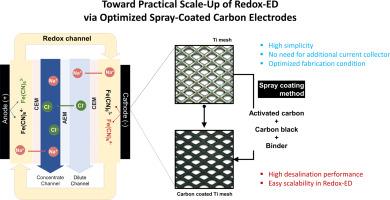优化可扩展氧化还原电渗析系统的碳电极喷涂涂层
IF 9.8
1区 工程技术
Q1 ENGINEERING, CHEMICAL
引用次数: 0
摘要
氧化还原介导的电渗析(redox- ed)是一种很有前途的海水淡化技术,它用可持续的氧化还原反应代替水分解,从而提高能源效率并降低运营成本。然而,传统多孔碳电极(如活性炭布和毡)的可扩展性受到电位分布差和结构可调性有限的阻碍。在这项研究中,我们提出了一种可扩展的电极制造方法,将活性炭、炭黑和聚偏氟乙烯(PVDF)粘合剂喷涂到钛网基片(3 × 3 cm2)上,粘合剂含量为2至6 g (AC2-AC6)。其中,AC5电极表现最好,其比容量为570.6 mAh/g,几乎是ac2的两倍,比表面积(1361.6 ~ 1877.5 m2/g)增大,电化学活性表面积(6.03 ~ 8.63 cm2)减小,电荷转移电阻(1.8 ~ 0.9 Ω)。AC5的除盐率为1295.3 mmol/m2/h,充电效率为98.9%,能耗为117 kJ/mol。重要的是,这项工作首次展示了成功地将喷涂电极缩放到实际尺寸(15 × 6 cm2,大120倍),并将它们集成到12对堆叠的氧化还原- ed系统中。本研究设想,喷雾涂层作为氧化还原ed的一种变革性制造方法,为大规模、高性能和经济上可行的海水淡化提供了一种简单、可调和工业准备的途径。本文章由计算机程序翻译,如有差异,请以英文原文为准。

Optimizing carbon electrode spray coating for scalable redox electrodialysis systems
Redox-mediated electrodialysis (redox-ED) is a promising desalination technology that substitutes water splitting with sustainable redox reactions, thereby improving energy efficiency and reducing operational costs. However, the scalability of conventional porous carbon electrodes-such as activated carbon cloth and felt-is hindered by poor potential distribution and limited structural tunability. In this study, we propose a scalable electrode fabrication method using spray coating of activated carbon, carbon black, and polyvinylidene fluoride (PVDF) binder onto titanium mesh substrates (3 × 3 cm2) with binder contents ranging from 2 to 6 g (AC2–AC6). Among these, the AC5 electrode showed the best performance, delivering a specific capacity of 570.6 mAh/g—nearly double that of AC2—with an enlarged specific surface area (1361.6 to 1877.5 m2/g) and electrochemical active surface area (6.03 to 8.63 cm2) reduced charge transfer resistance (1.8 to 0.9 Ω). AC5 also optimized a salt removal rate of 1295.3 mmol/m2/h, charge efficiency of 98.9 %, and energy consumption of 117 kJ/mol. Importantly, this work provides the first demonstration of successfully scaling spray-coated electrodes to a practical dimension (15 × 6 cm2, 120-fold larger) and integrating them into a 12-pair stacked redox-ED system.
This study envisions the spray coating as a transformative fabrication approach for redox-ED, offering a simple, tunable, and industry-ready pathway toward large-scale, high-performance, and economically viable desalination.
求助全文
通过发布文献求助,成功后即可免费获取论文全文。
去求助
来源期刊

Desalination
工程技术-工程:化工
CiteScore
14.60
自引率
20.20%
发文量
619
审稿时长
41 days
期刊介绍:
Desalination is a scholarly journal that focuses on the field of desalination materials, processes, and associated technologies. It encompasses a wide range of disciplines and aims to publish exceptional papers in this area.
The journal invites submissions that explicitly revolve around water desalting and its applications to various sources such as seawater, groundwater, and wastewater. It particularly encourages research on diverse desalination methods including thermal, membrane, sorption, and hybrid processes.
By providing a platform for innovative studies, Desalination aims to advance the understanding and development of desalination technologies, promoting sustainable solutions for water scarcity challenges.
 求助内容:
求助内容: 应助结果提醒方式:
应助结果提醒方式:


